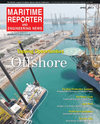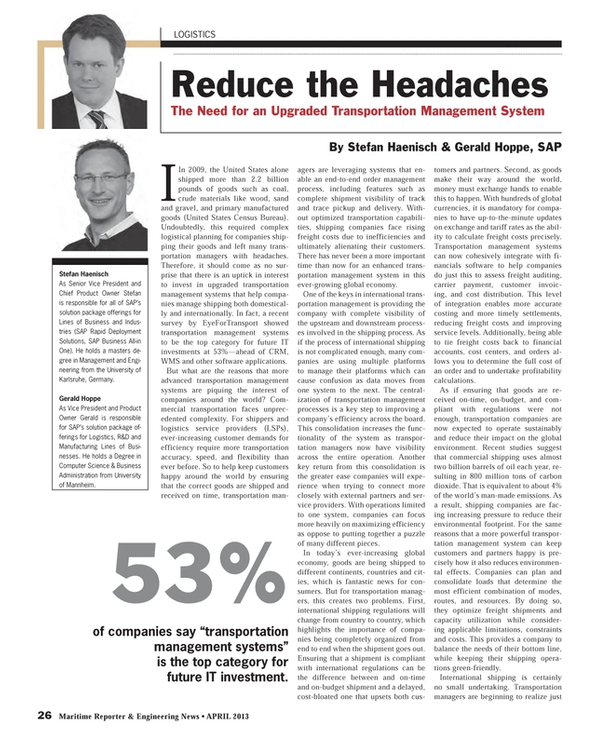
A Call for Transportation Management Upgrades
Reduce the Headaches: The Need for an Upgraded Transportation Management System
In 2009, the United States alone shipped more than 2.2 billion pounds of goods such as coal, crude materials like wood, sand and gravel, and primary manufactured goods (United States Census Bureau). Undoubtedly, this required complex logistical planning for companies shipping their goods and left many transportation managers with headaches. Therefore, it should come as no surprise that there is an uptick in interest to invest in upgraded transportation management systems that help companies manage shipping both domestically and internationally. In fact, a recent survey by EyeForTransport showed transportation management systems to be the top category for future IT investments at 53%—ahead of CRM, WMS and other software applications.
But what are the reasons that more advanced transportation management systems are piquing the interest of companies around the world? Commercial transportation faces unprecedented complexity. For shippers and logistics service providers (LSPs), ever-increasing customer demands for efficiency require more transportation accuracy, speed, and flexibility than ever before. So to help keep customers happy around the world by ensuring that the correct goods are shipped and received on time, transportation managers are leveraging systems that enable an end-to-end order management process, including features such as complete shipment visibility of track and trace pickup and delivery. Without optimized transportation capabilities, shipping companies face rising freight costs due to inefficiencies and ultimately alienating their customers. There has never been a more important time than now for an enhanced transportation management system in this ever-growing global economy.
One of the keys in international transportation management is providing the company with complete visibility of the upstream and downstream processes involved in the shipping process. As if the process of international shipping is not complicated enough, many companies are using multiple platforms to manage their platforms which can cause confusion as data moves from one system to the next. The centralization of transportation management processes is a key step to improving a company’s efficiency across the board. This consolidation increases the functionality of the system as transportation managers now have visibility across the entire operation. Another key return from this consolidation is the greater ease companies will experience when trying to connect more closely with external partners and service providers. With operations limited to one system, companies can focus more heavily on maximizing efficiency as oppose to putting together a puzzle of many different pieces.
In today’s ever-increasing global economy, goods are being shipped to different continents, countries and cities, which is fantastic news for consumers. But for transportation managers, this creates two problems. First, international shipping regulations will change from country to country, which highlights the importance of companies being completely organized from end to end when the shipment goes out. Ensuring that a shipment is compliant with international regulations can be the difference between and on-time and on-budget shipment and a delayed, cost-bloated one that upsets both customers and partners. Second, as goods make their way around the world, money must exchange hands to enable this to happen. With hundreds of global currencies, it is mandatory for companies to have up-to-the-minute updates on exchange and tariff rates as the ability to calculate freight costs precisely. Transportation management systems can now cohesively integrate with financials software to help companies do just this to assess freight auditing, carrier payment, customer invoicing, and cost distribution. This level of integration enables more accurate costing and more timely settlements, reducing freight costs and improving service levels. Additionally, being able to tie freight costs back to financial accounts, cost centers, and orders allows you to determine the full cost of an order and to undertake profitability calculations.
As if ensuring that goods are received on-time, on-budget and compliant with regulations were not enough, transportation companies are now expected to operate sustainably and reduce their impact on the global environment. Recent studies suggest that commercial shipping uses almost two billion barrels of oil each year, resulting in 800 million tons of carbon dioxide. That is equivalent to about 4% of the world’s man-made emissions. As a result, shipping companies are facing increasing pressure to reduce their environmental footprint. For the same reasons that a more powerful transportation management system can keep customers and partners happy is precisely how it also reduces environmental effects. Companies can plan and consolidate loads that determine the most efficient combination of modes, routes, and resources. By doing so, they optimize freight shipments and capacity utilization while considering applicable limitations, constraints and costs. This provides a company to balance the needs of their bottom line, while keeping their shipping operations green-friendly. International shipping is certainly no small undertaking. Transportation managers are beginning to realize just how complex this process has become as the economy continues to span the globe, bringing in new currencies, regulations and destinations for goods. As supply chains grow longer, the likelihood increases for loss of visibility, inflated logistics costs, and missed customer service commitments.
The need for transparency and visibility across the entire process has never been more important. Only a comprehensive management method supporting the complete order lifecycle provides the capability to plan, consolidate, and optimize all shipments – inbound and outbound, domestic and international – while considering real-world constraints and costs. Tight integration with financial software and analytics enable companies to help keep costs down on shipping while making sure that their do not sacrifice customer service. Ultimately, as companies continue to improve their overall operations when considering costs and constraints, they will also be able to reduce their carbon footprint by minimizing unnecessary travel.
In the survey mentioned at the beginning, 53% of respondents said that transportation management systems were the top category for future IT investments. Companies no longer have a reason to not upgrade their current systems. Solution providers have made it possible to have fully-operational systems up and running in a matter of weeks, while ensuring flexibility so that as the transportation company grows, the system can continue to handle what is asked of it. Transportation management systems help companies balance efficiency and effectiveness to achieve better-than average delivery performance with lower-than-average spending on transportation. International shipping can be made easier and examining how effective your current system is can be the first step to simplifying this process.
(As published in the April 2013 edition of Maritime Reporter & Engineering News - www.marinelink.com)
Read A Call for Transportation Management Upgrades in Pdf, Flash or Html5 edition of April 2013 Maritime Reporter
Other stories from April 2013 issue
Content
- The Glass Half Full page: 6
- Salvage Response under OPA 90: Non-Tankers are Next page: 10
- Does Chapter 11 Work for Foreign Shipping Companies? page: 18
- Understanding the Ups and Downs of Insurance page: 22
- A Call for Transportation Management Upgrades page: 26
- Keeping Marine Projects Afloat page: 29
- Floating Production Systems to Grow 40% in Five Years page: 32
- Making Flare Gas Useful page: 34
- Underwater Robotic Championship page: 44
- 3D Body Scanning page: 46
- WSS’ Global Quest page: 48
- Dredging India page: 50
- Markey’s Mark on the Deck Machinery page: 54
- Nor Crane Powers Ahead page: 56
- Keeping Maritime and Offshore Cranes Ship Shape page: 58
- CIMAC Set for Shanghai page: 62
- Dead in the Water page: 64


